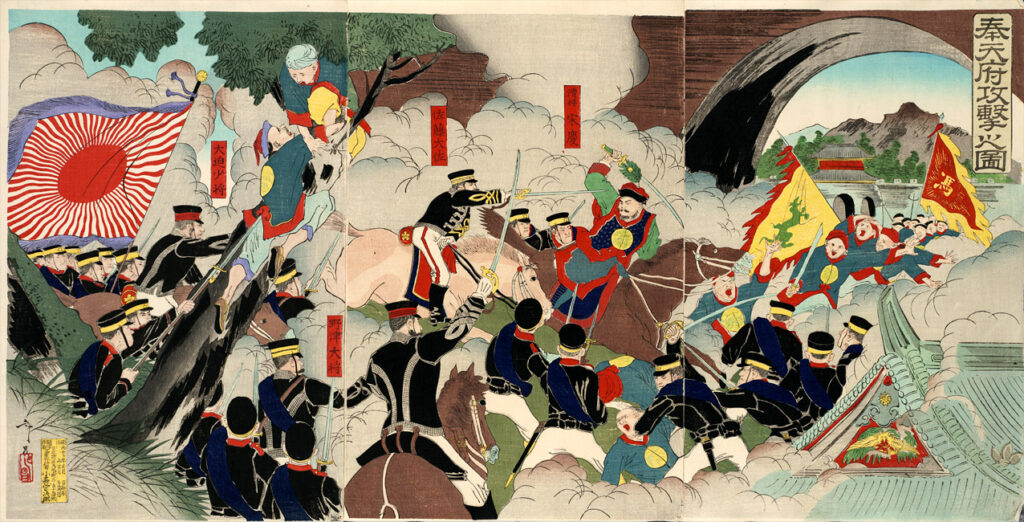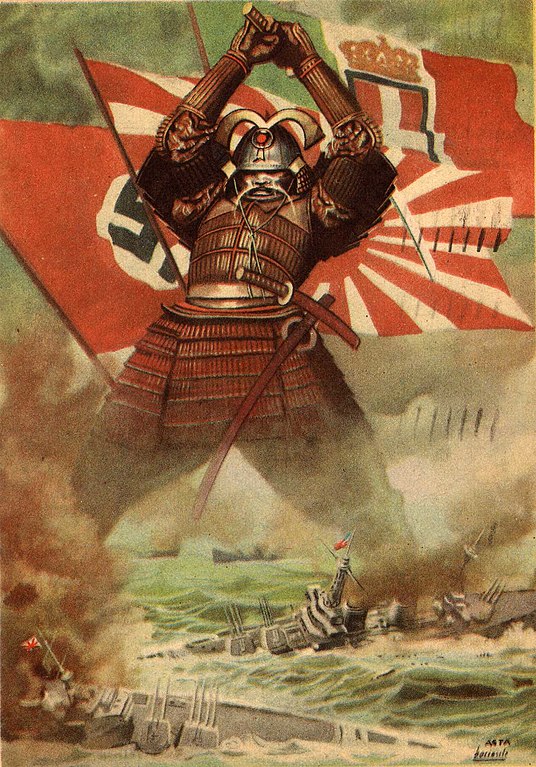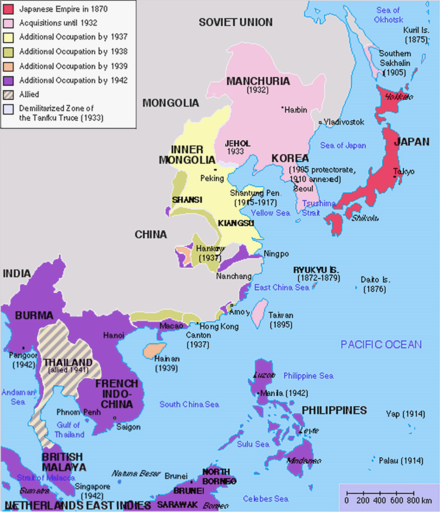
“For Watsuji there is no totality of the state (kokka) without the people (minzoku). The minzoku as defined in relation to the totality of the kokka has its own “individuality,” what we commonly call a people’s “ethnicity” … Since the greatest totality of ningen is the ethnic people, Watsuji made the people virtually equivalent to the state, the greatest political totality” (Thomas Kasulis). This conflation between the “people” and the “state” is what Kasulis will single out as the “flaw” in Watsuji’s theory.
Kasulis’ analysis of Watsuji Tetsuro’s understanding of ethics can be summed up in the following statement: “To be a person is to live in the midst of aidagara and to authenticate is as such by preserving the two poles of the individual (nin) and the collective (gen),” which is made even more explicit in this second statement: “To be an individual is to be an-individual-as-opposed-to-the-social; to be the social is to be the-social-as-opposed-to-being-an-individual. If either pole were to completely eradicate the other, neither pole could exist.”

Watsuji’s Ethics was published in three volumes in 1937, 1942 and 1949, a time when a particularly virulent nationalism was gaining ground in Japan, which led to the attack on Pearl Harbor in 1941, Japan’s four year war with the US, and its aftermath. We cannot help asking: “To what extent has this particularly dramatic period in Japan’s history triggered Watsuji’s concern for ethics, and shaped his ethical system?
The philosophical inquiries of Nishida Kitaro and Nishitani Keiji had focused on the individual at the expense of the socio-political dimension. Tanabe Hajime, who had been invited by Nishida to Kyoto University, and succeeded him when he retired, is known for having fully embraced and supported nationalism, a decision for which he later expressed repentance. Although both Nishida, at the time regarded as the most prominent Japanese philosopher, and Nishitani, still only in his forties, were invited by the government to express their views on the war with the West, it was Watsuji, the thinker who devoted most of his career to the relationship between the individual and the social, who most probably felt most concerned by the political turmoil.
Totality and unity
Before looking at how Watsuji reacted to the crisis, Kasulis looks more closely at how the double negation of the nin and the gen works out when applied to the state. More precisely his point of entry is the contrast between Watsuji’s concepts of “totality” and “unity.”
“If we think of unity as oneness, when unity is established, the parts constituting it dissolve into the whole like drops of water disappearing into an ocean. By contrast, a totality is a whole that preserves its parts without dissolving them into one: a magnet is a totality of individual molecules of iron aligned so that all their positive poles face in one direction and negative poles in the other. The individual molecules do not dissolve into the totality, but rather keep their ‘individuality’.
Kasulis explains that Watsuji’s idea of the state is “a totality that includes the “people” without dissolving them into an abstract unity. For Watsuji there is no totality of the state (kokka) without the people (minzoku). The minzoku as defined in relation to the totality of the kokka has its own “individuality,” what we commonly call a people’s “ethnicity” However, Kasulis points out “Since the greatest totality of ningen is the ethnic people, Watsuji made the people virtually equivalent to the state, the greatest political totality.” This conflation between the “people” and the “state” is what Kasulis will single out as the “flaw” in Watsuji’s theory. But before explaining why, Kasulis wants to show “how Watsuji’s standpoint gave him a stage for critique against western imperialism.”
A Japanese concept of “federalism” as an alternative to Western imperialism

We should not, indeed, forget that what fueled Japan’s military campaign that became known as the Greater East Asian Co-prosperity Sphere, was a reaction against a series of attacks from Western nations against many Asian states, seeking either outright colonisation, or, whenever not achievable, the imposition of usually unfair trade treaties. This is what had motivated Japan’s seclusion from the West until 1868, and its determination to develop its economy and military strength since that date, which had marked the beginning of the Meiji Era.
Kasulis reminds us that “western imperialism sees the role of the state as bringing about material well-being, safety, and (following Francis Bacon) the dominance of nature through technology. The nations who are best at fulfilling that role are entitled, perhaps even obligated to employ their system to regulate other countries through imperial expansion. Since all people are in essence the same, one system fits all.”
Now, as we have seen with Watsuji’s ideas in Fudo, for the Japanese, not all people are the “same.” As the expression of their land, its geographical characteristics, its climate, as well as its history, the culture that has unfolded since time immemorial in response to these spatial elements, people share different sets of common views and behaviours that, for them, function as a ground for understanding and trust, and ultimately a harmonious peaceful life.
Kasulis explains that, in contrast, Watsuji was sure “Japan could pose an alternative. He believed Japan could facilitate, at least in East Asia, a federation of nation states, each with its own cultural and political self-determination but united against western military expansion. The advantage of envisioning the state as a totality along the lines he outlined, Watsuji argued, is that such a state is internally all-inclusive of its people (all the Japanese people are included in Japan, for ex.), but it is self-contained and need not oppose the formation of other nation states, that is, other political totalities generated by other “peoples” … Watsuji’s vision of globalism was that each country should be free to develop out of its own fudo, including its own government structure, but to do so in a way that allows other peoples in other countries to do the same for themselves.” In View of the World, View of the Nation, Nishitani argued for a similar type of globalism that allows each country to retain their fudo, and this is a view that one would have found in the federation of indigenous tribes in the US and Canada that existed before the arrival of Western immigrants. It is a view shared by all social groups who see themselves as having emerged “naturally” out of early tribal groups, without any subsequent colonisation by powerful empires, that inevitably led to migrations of people and a mixing of languages and cultures. It goes without saying that such homogenous populations cannot be found in today’s large states where people from all over the world live side by side.
So, for Watsuji, Kasulis asserts, “the Pacific War was a conflict over competing ideologies of empire, each arising out of its own philosophical anthropology.” The Japanese “anthropology assumes that human being, in all the most important and fundamental senses, attain their human individuality and dignity by being “of a people,” by flourishing within an inter-responsive field of local physical and cultural conditions. So, global politics should develop in a manner guaranteeing the preservation of those varying local conditions and the polities that have arisen within them. Global politics should take its mission to be truly inter-national, not trans-national, protecting local differences in human environments rather than trying to transcend them. It may be universally true that all homo sapiens share the need for a minimal daily intake of calories and nutrition, for example, but that does not mean everyone should eat the same food.”
Furthermore, Watsuji and many other Japanese philosophers of his time saw the conflict as a “moment of world history,” that is, a pivotal point of global significance. For the first time Japan was playing a role on the world stage, in the vanguard against a form of western imperialism that had imperiled the sovereignty of Asian cultures for centuries. For the first time in modern history, they argued, there was an Asian nation that had mastered military technologies and could now stand up to the western imperialist powers.”
The problem, of course, is that what the nationalists in Japan’s government were pursuing under the concept of the Greater East Asian Co-prosperity Sphere, was not what they were idealising. The support of the intellectuals “for a vision, however naïve, of what Japan could do for East Asia was quickly interpreted by the government as support for its military agenda.” Kasulis tells us that Watsuji, however, “generally seemed to accept that interpretation, tweaking his philosophy by including nationalistic catchwords.” Worse, “Watsuji’s complicity in supporting government policies was even more visible in his valorization of the emperor system.”
The Japanese Imperial System
The two references made above to Watsuji’s “complicity” with the nationalist agenda of the government are not to be read as a signal that we have left the theoretical analysis of Watsuji’s stance. So, this analysis now turns to a reflection on the Japanese Imperial System. Kasulis writes: “The Japanese emperor system,” Watsuji argued, “is the most effective form of government for maintaining the highest level of totality, the state.” To help us understand that claim, I first want to stress what Watsuji did not say. Unlike the official State Shinto ideology of the time, Watsuji did not accept the myths of divine origin as literally true; nor did he think of the emperor as an incarnate god sitting on the throne. Watsuji emphasized the reverence for the emperor more than the emperor himself … For Watsuji, the emperor was an open-ended (actually a kind of emptiness) in this world, a creation of the people to focus and unify themselves into a state. In that respect, Watsuji believed the function of the emperor system to be primarily ethical, rather than religious or even simply political. The absoluteness of the emperor system, therefore, is in the function of the emperor, not the physical person of the emperor. Stated another way, for Watsuji, the emperor system is about how reverence creates a totality, not what is revered … Revering the emperor is the absolutely totalizing function that makes possible a unified Japanese state.” Kasulis also notes that even in Shinto, kami were not regarded as perfect, infallible, and omnipotent deities the way God is in a monotheist context. Still, they were revered. “The emperor, therefore, symbolizes that venerating attitude and conduct (the emperor is not, as a person, the object of that veneration) … the emperor symbolizes how the Japanese feel united in a totality not what makes them feel that way.”
Watsuji, after all, “was a secular humanist not prone to religious fervor of any hue.” Still, Kasulis notes, Watsuji “did little to disassociate his philosophy from the official state ideology and he continued to defend the imperial system vociferously even after the war ended.”
The reason why Kasulis is so annoyed with this support of the imperial system is that it is what led Watsuji to “commit a logical error” in his conception of totality. “It goes back to the two senses of betweenness mentioned earlier: the betweenness of emptiness that logically precedes and makes possible the differentiation and logical tension between nin and gen (also called the originary totality) vs. the betweenness inherent in the collective pole, the gen of the ningen. That is, ningen is one kind of betweenness, namely, one that exists in the tension between the individual and the collective. The other kind of betweenness is that of collective itself (gen); as a collective, it is a totality between or among people.” According to Kasulis, keen as he was to aim at the greatest “number of people acting in unison with a common sense of purpose,” Watsuji did not see “that if his idealized view of a perfect totality identified the nin and the gen, that would also mean there are no longer two poles and the dialectical tension needed for ethics to occur would be lost. In effect, at the highest level of totality, the nin becomes all people (the people?) and gen the state. What then could the nin negates itself into or what could the gen negate itself into? If the people negate itself into the state or the state into the people, the totality is negating itself into an alternative description of what it already is. Like a computer glitch, the dynamism of Watsuji’s dialectic freezes into a stasis.” The identification of the state with the people puts an end to the dialectical process as it nullifies the individual. Kasulis, however, notes that this issue is a matter of “mis-application” of Watsuji’s ethical theory rather than one concerning the theory itself.
Concluding Evaluation
Notwithstanding this last remark about the mis-application of Watsuji’s theory, Kasulis’ assessment of Watsuji’s ethics is far from wholeheartedly positive. The context, of course, was exceptional. The country was at war. This, as such, wasn’t new: Japan had been involved in one war after another for decades, but this particular war against Western powers, was the first ever to endanger the sovereignty of Japan, given that the Mongols had failed to invade the country in the 13th century.
Kasulis writes: “There is much we can learn from, and perhaps philosophically salvage, from Watsuji’s ethical theory. His system was not foolproof, however, and Watsuji himself was eventually fooled by it. A way to state the problem simply is that Watsuji let the logic of the double negation be overwhelmed by the gen of ningen in which the highest level of his dialectic transformed nin into “the people” (minzoku) and gen into “the state” (kokka), melding them into a totality of “allness” (he used the German Allheit).” In other words, the result had been a totalitarian state.
Kasulis adds: “Watsuji did see how the inability to change was poisoning Japanese wartime politics, but he attributed it to the dominant ideology of State Shinto and did not see it lurking between the lines of some of his own theorizing.”
Though Kasulis could not bring himself to agree with Watsuji’s overall philosophy of ethics, he does recognise merit in some of its aspects. In the final lines of the chapter, Kasulis writes: “I do find his phenomenology of human existence to be astute and a powerful corrective to philosophical anthropologies that overly privilege the individual. Furthermore, his analysis highlights the importance of cultural differences and exposes the fantasy of socially construed identities that assume universal human and social qualities. Watsuji presents us with a view of human existence, agency, and value that is somehow both commonsensical and profound in its implications. Yet, in its push toward an absolute endpoint, a perfect integrated unity or totality, Watsuji’s theory – like so many other rational systems – overextended itself with disastrous consequences.”
One thought that kept surfacing in my mind throughout Kasulis’ assessment of Watsuji’s overemphasis on the social at the expense of the individual is that it comes out of the mind of a man brought up in a Western context where an opposite overemphasis on individualism is rife, and now looked upon as problematic. Again, when you hear an indigenous American speak of “his people,” he spontaneously conflates belonging to, say, the Cree or the Ojibwe, with adhering to what Watsuji would call the fudo of either the Cree or the Ojibwe. Watsuji obviously saw the imperial system as an element of the Japanese’ fudo, as it had arisen even before Japan’s adoption of Chinese culture, and survived over half a millennium of a much diminished role of the Emperor whose power had been taken away by the military government of the shogun in Kamakura. Furthermore, Watsuji’s envisioning of a federative globalism that allows each state to retain their own mode of government together with the other elements of their fudo, would have allowed Japan to retain its emperor without imposing a similar type of government on other states. So, Watsuji’s ethical system was consistent. With regard to the curtailing of individual freedom in time of war, isn’t it fair to say that it is something that occurs in all countries thrown into similar conflicts, whatever type of political regime they had in time of peace. In addition, there is today a current emphasis among ecologists on the “local” as they argue that not only does it saves energy spent on transportation in a trade system, but going local is the only way, in the long term, people will be motivated to take good care of their soils, as well as the quality of their produce. “Local” in modern states can no longer be based on a common fudo, but in practical terms, it still has to take into account the geographical and cultural elements of the people you work with to produce healthy food.
I was then curious to know what Robert Carter, the translator of Rinrigaku, and one of the pioneers in the study of Watsuji’s thought. This is what he says in the book on his introduction to the Kyoto School he published in 2013:
“Watsuji’s emphasis on the state as the culmination of ethics and human culture, and on the importance of loyalty to the emperor, caused him to be branded as a right-wing totalitarian by some, particularly after WWII. His patriotic nationalism was cause for concern, but, in the context of a nation attempting to rediscover itself after defeat in war, it is really not surprising that he might overemphasize the Japanese legacy, or highlight the importance of the emperor as the secular and religious head of the greater Japanese family. His emphasis on the state as the culmination of ethics may be the major issue, for such emphasis seems to privilege the social over the individual. Having so brilliantly shown that the dual-nature of human beings is an ongoing and dynamic interplay between the individual and social nature of self, one in which the tension between the two persists in self-contradictory harmony, it would be a disappointment for this important analysis to collapse into a porridge-like state that simply engulfed the individuals it incorporated. My assessment is that, while the power of the state over individuals remains a real issue in his writings, the thrust of his word on ethics lies with ningen, which encompasses both the individual and the social, on nothingness as the betweenness between us, and on the positive attitudes which the Japanese bring to, or find in, their remarkably fruitful encounters in the betweenness.”
So, overemphasis on the state was still an issue for Carter, though he is careful to end on a positive note. When he wrote the entry on Watsuji in the Stanford Encyclopedia of Philosophy in 2019, Carter was more positive:
He writes: “It must be kept in mind that [Watsuji’s] intent was not to advocate tyranny or fascism, but to seek out an ethical and social theory whereby human beings as human beings could interact easily and fruitfully in the space between them, creating as a result a society, and a world-wide association of societies which selflessly recognized the value of the individual and the crucial importance of the well-being of the whole. His solution may have been inadequate, and open to unwelcome misuse. His analysis of ‘betweenness’ shows it to be communality, and communality as a mutuality wherein each individual may affect every other individual and thereby affect the community or communities; and the community, as an historical expression of the whole may affect each individual. Ideally, what would result would be an enlightened sense of our interconnectedness with all human beings, regardless of race, color, religion, or creed, and a selfless, compassionate capacity to identify with others as though they were oneself. By reintroducing a vivial sense of our communitarian interconnectedness, and our spatial and bodily place in the betweenness between us, where we meet, love, and strive to live ethical lives together, Watsuji provides an ethical and political theory which might well prove to be helpful both to non-Japanese societies, and to a modern Japan itself which is torn between what it was, and what it is becoming.”
Little is said about Watsuji in Rude Awakenings – Zen, the Kyoto School and the Question of Nationalism because Watsuji is not officially regarded as a member of the Kyoto School. The book does, however, offer the views of a range of scholars on both individual Kyoto School thinkers and the question as to whether Kyoto School philosophy as such is nationalistic.
Sources
Thomas P. Kasulis – Engaging Japanese Philosophy (2018)
Robert E. Carter – The Kyoto School – An Introduction (2013)

